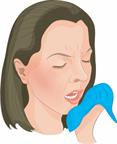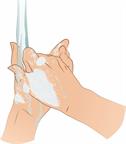Influenza, Adult
Influenza is also called the flu. It's an infection that affects your respiratory tract. This includes your nose, throat, windpipe, and lungs.
The flu is contagious. This means it spreads easily from person to person. It causes symptoms that are like a cold. It can also cause a high fever and body aches.
What are the causes?
The flu is caused by the influenza virus. You can get it by:
Breathing in droplets that are in the air after an infected person coughs or sneezes.
Touching something that has the virus on it and then touching your mouth, nose, or eyes.
What increases the risk?
You may be more likely to get the flu if:
You don't wash your hands often.
You're near a lot of people during cold and flu season.
You touch your mouth, eyes, or nose without washing your hands first.
You don't get a flu shot each year.
You may also be more at risk for the flu and serious problems, such as a lung infection called pneumonia, if:
What are the signs or symptoms?
Flu symptoms often start all of a sudden. They may last 4–14 days and include:
Fever and chills.
Headaches, body aches, or muscle aches.
Sore throat.
Cough.
Runny or stuffy nose.
Discomfort in your chest.
Not wanting to eat as much as normal.
Feeling weak or tired.
Feeling dizzy.
Nausea or vomiting.
How is this diagnosed?
The flu may be diagnosed based on your symptoms and medical history. You may also have a physical exam. A swab may be taken from your nose or throat and tested for the virus.
How is this treated?
If the flu is found early, you can be treated with antiviral medicine. This may be given to you by mouth or through an IV. It can help you feel less sick and get better faster.
Taking care of yourself at home can also help your symptoms get better. Your health care provider may tell you to:
The flu often goes away on its own. If you have very bad symptoms or problems caused by the flu, you may need to be treated in a hospital.
Follow these instructions at home:
Activity
Eating and drinking
-
Take an oral rehydration solution (ORS). This is a drink that is sold at pharmacies and stores.
-
Drink enough fluid to keep your pee pale yellow.
-
Try to drink small amounts of clear fluids. These include water, ice chips, fruit juice mixed with water, and low-calorie sports drinks.
-
Try to eat bland foods that are easy to digest. These include bananas, applesauce, rice, lean meats, toast, and crackers.
-
Avoid drinks that have a lot of sugar or caffeine in them. These include energy drinks, regular sports drinks, and soda.
-
Do not drink alcohol.
-
Do not eat spicy or fatty foods.
General instructions
-
Take your medicines only as told by your provider.
- Use a cool mist humidifier to add moisture to the air in your home. This can make it easier for you to breathe. You should also clean the humidifier every day. To do so:
Empty the water.
Pour clean water in.
-
Cover your mouth and nose when you cough or sneeze.
-
Wash your hands with soap and water often and for at least 20 seconds. It's extra important to do so after you cough or sneeze. If you can't use soap and water, use hand sanitizer.
How is this prevented?

Contact a health care provider if:
-
You get new symptoms.
-
You have chest pain.
-
You have watery poop, also called diarrhea.
-
You have a fever.
-
Your cough gets worse.
-
You start to have more mucus.
-
You feel like you may vomit, or you vomit.
-
You become short of breath or have trouble breathing.
-
Your skin or nails turn blue.
-
You have very bad pain or stiffness in your neck.
-
You get a sudden headache or pain in your face or ear.
-
You vomit each time you eat or drink.
These symptoms may be an emergency. Call 911 right away.
This information is not intended to replace advice given to you by your health care provider. Make sure you discuss any questions you have with your health care provider.


